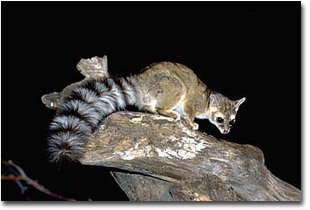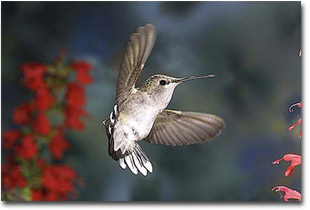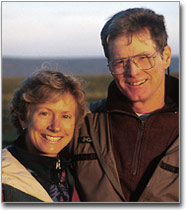|
|
 Flash Primer 3 - Understanding Guide Numbers Photography and Text Copyright Joe McDonald The burst of light from an electronic flash is extremely brief, lasting from what is a relatively slow 1/400th or 1/800th of a second to as fast as 1/50,000th of a second. At the slow end, the action-stopping ability of a flash is less than what is possible with a camera’s shutter speed. My Canon EOS 1v, for example, has a shutter speed of 1/8,000th, and many cameras have shutter speeds of 1/2000th or more. Fast flash durations come at a cost, however, both in price and in ‘power’ for lack of a better word. A flash’s power is determined by its Guide Number, with low Guide Numbers (GN) indicating a weak or less powerful flash than one with a high GN. For ease of comparison, most flash GNs are rated for an ISO 100 film. If you use a film with a lower ISO the GN will be lower, and, conversely, if you use a higher speed film the GN will be higher. But doubling the ISO does not double the GN, as many might expect. Perhaps the easiest way to explain this is to describe how a GN is determined. The GN is found by multiplying the flash-to-subject distance by the f-stop required for a correct exposure of the subject at that distance. Although any distance could be used, 10 foot is the easy standard. Let’s say you obtain an f-stop of f11 by doing your test. This could be done via a flash meter held ten feet from the flash, or it could also be determined by firing a series of exposures and choosing the best one. This wastes some film but is accurate, provided you’re shooting a middle-tone subject where changes in exposure can be accurately determined. If f11 is best, then by simply following the GN formula of GN= f-stop X distance, or GN= f11 X 10 feet, you’ll get a GN of 110 for ISO 100 film. If you use ISO 50 film, the GN is NOT 55. Since ISO 50 is one stop less light sensitive than ISO 100, you’d have an aperture of f8 at ten feet with the same light source. Following the formula, GN=f-stop X distance, you’d have GN= f8 x 10 feet or GN of 80. Just to drive the point home, the GN for ISO 200 film would be 160 since you gain a stop of light with the faster film, so GN= f16 x 10 feet or 160.
There are flashes available that have a GN of 220 or even higher for ISO 100 film, and many flashes with a GN lower than 110. Unfortunately, many manufacturers exaggerate their flash’s GN for outdoor situations. If you’d like to check your flash for an accurate GN, do it outdoors where white reflective walls won’t bounce light back to your subject or to your meter. I sometimes think that manufacturers test their flashes by firing them through a 10 feet long aluminum pipe to guarantee all the light hits their flash meter! That’s not how real photography works. Higher GN flashes are generally more versatile. They can be used at a greater flash-to-subject distance. For example, if you had three different flash units with GNs of 80, 160, and 220 for ISO 100 film, at f8 the first flash would need to be placed at 10 feet, the second flash at 20 feet, and the third flash at 27.5 feet. How did I get these numbers? If you transpose the formula, GN=f stop X distance, algebraically to GN/distance = f-stop, or GN/ f-stop = distance, you can find the exact distance required to use a manual flash for a given f-stop, or, with TTL, the maximum distance a flash can be placed for a given f-stop. It is extremely useful to understand the importance of GN when picking a flash. For my money, I’d rather have a flash that would allow me to fire at close to 30 feet at f8 rather than only 10 feet. Normally, with TTL flash, we don’t worry about the flash-to-subject distance since the camera’s flash sensors govern the exposure. The flash’s distance scale tells you the minimum and maximum flash distance for any given f-stop within which the flash will properly function. With a high GN flash, this range is much greater. When doing any flash work where stopping the action is important we have to understand one more concept – flash duration. This is most easily controlled in manual flash mode. With a flash on manual mode, there is usually a power ratio setting that reduces the flash’s output by full stops as it is reduced in power by halves. Some flashes go from Full Power to 1/2, 1/4, 1/8, 1/16, 1/32, and even 1/64 and 1/128 power, where the GN would drop, correspondingly, from 220 as an example, to 160, 110, 80, 56, 40, 28, and 20 at the 1/128th power setting.
Some flashes have power ratios that go in thirds of stops rather than full stops. Typically the high end flashes by Nikon, Canon, and Sunpak have these smaller increments on the manual mode setting. These power settings, or ratios, are determined not by the intensity of the light but by the flash’s duration. A flash that fires at Full Power may have a flash duration of only 1/800th sec., while the same flash at 1/16th power might have a duration of 1/6000th or less. At the lowest power ratio settings a flash might fire as briefly as 1/30,000th sec. on manual mode. Thus a low power ratio setting will result in a fast or very brief flash duration. But how do you know how fast your flash is? What is the flash duration at a given power ratio? Unfortunately, these days that’s very difficult to know! The three most recent commercial flashes I’ve purchased – a Canon 550EX, a Vivitar 285, and a Sunpak 383, had no information in the instruction booklet regarding actual flash duration. Someone just starting in flash might never know that a low power ratio produces a faster flash duration. Fast flash durations are necessary to stop action, but as the speeds increase as you lower your power ratio settings the power, or GN, drops. In turn, this requires you to have your flash relatively close to your subject if you’re using a small aperture. Let me illustrate how this would apply in a real situation. To stop the wing movements of a flying hummingbird I’d want to use a fast flash. I might also wish to use an aperture of f22 to obtain maximum depth of field. With my 550EX, the GN drops to about 50 at 1/8th power and 17 at 1/128th power. To use an aperture of f22 I would need to place my flash approximately 2.3 feet from the subject if I used a power ratio setting of 1/8th. I derived this by following the formula GN/f-stop = distance, or 50/22 = approximately 2.3 feet. That’s doable. For a faster flash duration, perhaps as fast as 1/30,000th sec. at a 1/128 power ratio, I’d now need to be about 9 inches from the subject (GN/22 = distance, or 17/22 = .7 feet. I’d suspect that’s a bit too close for a hummer to tolerate or for you to work around when making a composition. You might ask, why not just use TTL and place the flash 5 feet away? You can’t, because it won’t work. On TTL, the flash will emit a burst of light at a duration long enough to satisfy an f22 exposure, and that would probably be too slow to stop the hummer’s wings. For the type of work that I often do, using high speed flash to capture animal action, I need a fast flash duration. Because I also want great depth of field, I’d like to have a high Guide Number as well. Unfortunately, fast flash durations and high Guide Numbers are usually mutually exclusive, but there are some specialty units available that combine the two. In a later column, I’ll be discussing these.
Somewhere in your flash manual the maximum duration might be stated. If not, you can make a rough guess by assuming that at Full Power your flash has a flash duration of about 1/1000th of a second. Each time you dial down one full stop, the duration is halved, so 1/2 power is 1/2000th sec, 1/4 power is 1/4000th, 1/8 power is 1/8000th, 1/16 power is 1/16,000th, and so on. If your maximum duration is printed, you can work out the exact duration for any power ratio by following the example given above. For serious high speed flash work, you really need to control the flash duration to select the speed necessary to get the job done. And that requires using the flash on manual mode and adjusting the power ratio. But as you’ve seen, low power ratio settings or high speed flash capabilities generally result in low guide numbers which requires having a flash placed close to the subject, sometimes inconveniently or impractically so. In our next installment, I’ll show you several ways that you can use high speed flash at greater distances, and put our entire lesson on flash to good use. Joe and Mary Ann - NPN 020 Comments on NPN flash photography articles? Send them to the editor.
Joe has been a full-time nature photographer since 1983, and Mary since 1989. They have led photo safaris to all seven continents, and spend as much as 20 weeks per year in Africa. Their work has appeared in every major natural history publication in North America. Joe is an active member of the Outdoor Writer’s Association of America and a former board member of the North American Nature Photography Association. Mary is a first place winner in the BBC/BG and Nature’s Best photo competitions. Joe and Mary maintain an active website that offers many features, including tips and questions of the month, a viewer’s gallery, product reviews and links, and trip reports and portfolios. Complete photo and digital course and photo tour descriptions are available on their website, www.hoothollow.com. |
|
|



 Joe and Mary Ann McDonald conduct photo and digital workshops at their home in Hoot Hollow, Pa., and lead photo tours and safaris around the world. Joe is the author of 6 books on wildlife photography and 1 on African wildlife; Mary is the author of 29 children’s books on natural history. Joe is a columnist for Outdoor Photographer Magazine, and Joe and Mary are columnists for photosafaris.com and Keystone Outdoors, and field correspondents for Nature’s Best Magazine.
Joe and Mary Ann McDonald conduct photo and digital workshops at their home in Hoot Hollow, Pa., and lead photo tours and safaris around the world. Joe is the author of 6 books on wildlife photography and 1 on African wildlife; Mary is the author of 29 children’s books on natural history. Joe is a columnist for Outdoor Photographer Magazine, and Joe and Mary are columnists for photosafaris.com and Keystone Outdoors, and field correspondents for Nature’s Best Magazine.